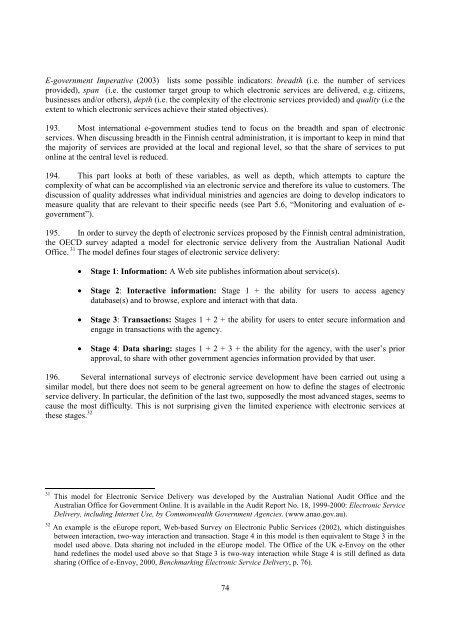e-GOVERNMENT IN FINLAND - ePractice.eu
e-GOVERNMENT IN FINLAND - ePractice.eu
e-GOVERNMENT IN FINLAND - ePractice.eu
Create successful ePaper yourself
Turn your PDF publications into a flip-book with our unique Google optimized e-Paper software.
E-government Imperative (2003) lists some possible indicators: breadth (i.e. the number of services<br />
provided), span (i.e. the customer target group to which electronic services are delivered, e.g. citizens,<br />
businesses and/or others), depth (i.e. the complexity of the electronic services provided) and quality (i.e the<br />
extent to which electronic services achieve their stated objectives).<br />
193. Most international e-government studies tend to focus on the breadth and span of electronic<br />
services. When discussing breadth in the Finnish central administration, it is important to keep in mind that<br />
the majority of services are provided at the local and regional level, so that the share of services to put<br />
online at the central level is reduced.<br />
194. This part looks at both of these variables, as well as depth, which attempts to capture the<br />
complexity of what can be accomplished via an electronic service and therefore its value to customers. The<br />
discussion of quality addresses what individual ministries and agencies are doing to develop indicators to<br />
measure quality that are relevant to their specific needs (see Part 5.6, “Monitoring and evaluation of egovernment”).<br />
195. In order to survey the depth of electronic services proposed by the Finnish central administration,<br />
the OECD survey adapted a model for electronic service delivery from the Australian National Audit<br />
Office. 31 The model defines four stages of electronic service delivery:<br />
x Stage 1: Information: A Web site publishes information about service(s).<br />
x Stage 2: Interactive information: Stage 1 + the ability for users to access agency<br />
database(s) and to browse, explore and interact with that data.<br />
x Stage 3: Transactions: Stages 1 + 2 + the ability for users to enter secure information and<br />
engage in transactions with the agency.<br />
x Stage 4: Data sharing: stages 1 + 2 + 3 + the ability for the agency, with the user’s prior<br />
approval, to share with other government agencies information provided by that user.<br />
196. Several international surveys of electronic service development have been carried out using a<br />
similar model, but there does not seem to be general agreement on how to define the stages of electronic<br />
service delivery. In particular, the definition of the last two, supposedly the most advanced stages, seems to<br />
cause the most difficulty. This is not surprising given the limited experience with electronic services at<br />
these stages. 32<br />
31 This model for Electronic Service Delivery was developed by the Australian National Audit Office and the<br />
Australian Office for Government Online. It is available in the Audit Report No. 18, 1999-2000: Electronic Service<br />
Delivery, including Internet Use, by Commonwealth Government Agencies. (www.anao.gov.au).<br />
32 An example is the eEurope report, Web-based Survey on Electronic Public Services (2002), which distinguishes<br />
between interaction, two-way interaction and transaction. Stage 4 in this model is then equivalent to Stage 3 in the<br />
model used above. Data sharing not included in the eEurope model. The Office of the UK e-Envoy on the other<br />
hand redefines the model used above so that Stage 3 is two-way interaction while Stage 4 is still defined as data<br />
sharing (Office of e-Envoy, 2000, Benchmarking Electronic Service Delivery, p. 76).<br />
74
















